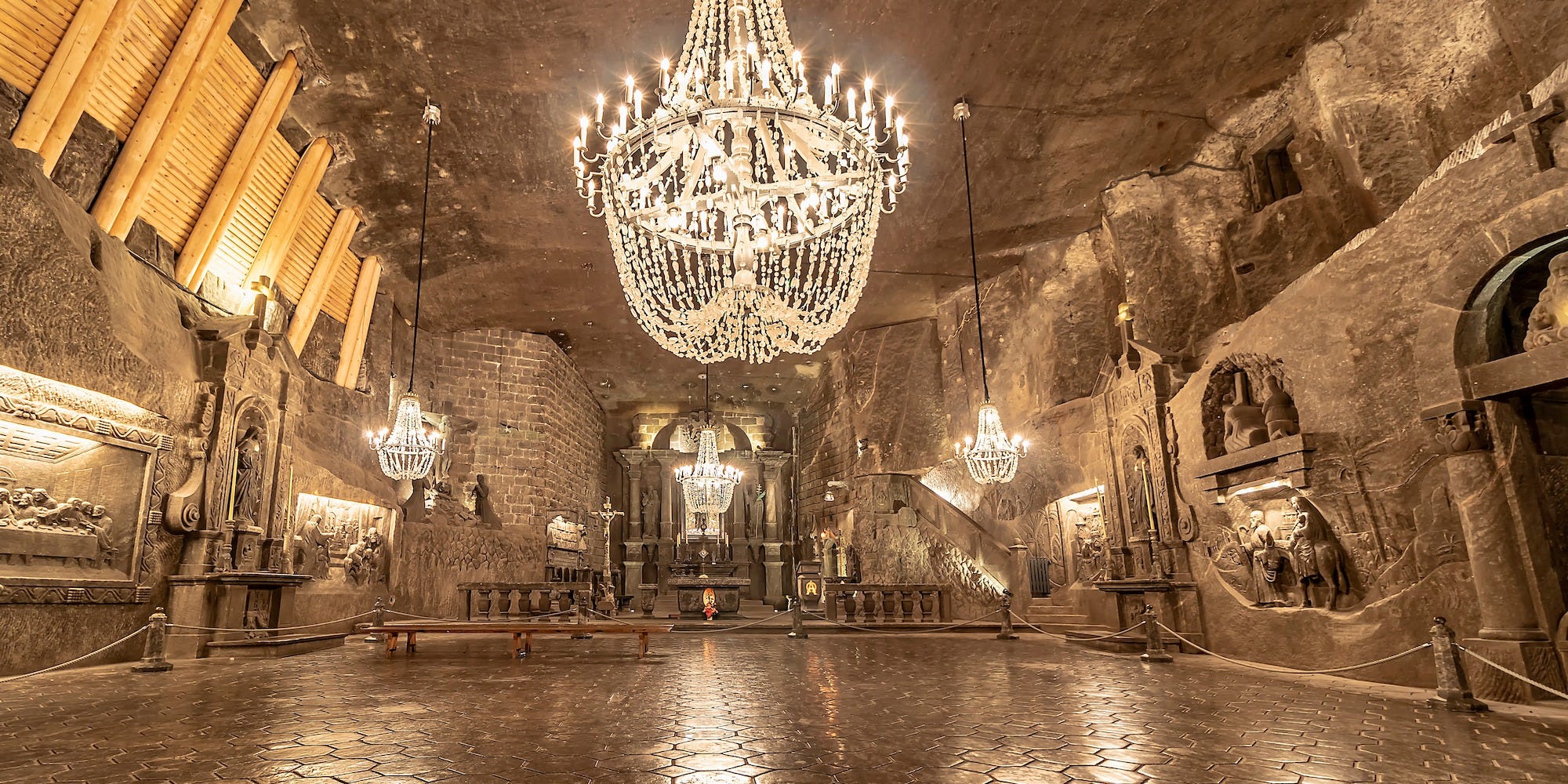- The ancient Wieliczka salt mine, begun in the 13th century, is now a UNESCO World Heritage site.
- The mine produced enormous wealth for Poland. But it also become a cultural treasure trove, filled with natural wonders like underground lakes and elaborate salt carvings.
- The mine’s caverns have been used to host royalty and world leaders as well as a world record attempt in underground ballooning.
- Visitors can travel almost 450 feet down and wander through a portion of the mine’s 152 miles of passageways.
- Visit Insider’s homepage for more stories.
The Wieliczka salt mine, near Krakow in southern Poland, is one of the world’s oldest continually operating mines and a UNESCO World Heritage site.
It has been mined since the 13th century.
The hollowed-out caverns left from digging have been transformed over the years into fairytale spaces: Great halls lit by salt chandeliers, chapels devoted to Polish saints, and walkways built to view underground lakes.
Many of the miners would become artists once they’d finished their dangerous work, carving intricate designs into the rock salt.
Continuous mining stopped in 1996, and it is now primarily a tourist venue. You can still visit the mine on walking tours that take you almost 450 feet underground.
Here's what you'll see if you visit Wieliczka salt mine.
Source: Wieliczka Salt Mine.
Wieliczka Salt Mine is about 10 miles outside of Krakow, one of Poland's most historic cities. The building that houses the mine entrance is pretty modest compared to what's underground.

At a depth of 330 feet, one of the most impressive rooms you reach is St Kinga's chapel, complete with chandeliers and devotional carvings into the salt walls.

St Kinga is an important saint in Poland and Lithuania, and is the patron saint of miners. As you might expect, she is thoroughly honored at Wieliczka. She features in a later scene carved entirely out of salt.
Source: Wieliczka Salt Mine.
After descending a grand staircase, you arrive in a vast hall lined with wall carvings and an altar to St Kinga at one end.

St Kinga's chapel even features a version of Leonardo da Vinci's "Last Supper" carved into a solid rock salt wall.

Here's a close-up of one of the salt chandeliers.

This salt-carved scene shows St Kinga. Legend says she asked for her wedding dowry in salt and miraculously made the mine appear at Wieliczka. Here, she is on the left, being presented with a lump of rock salt.
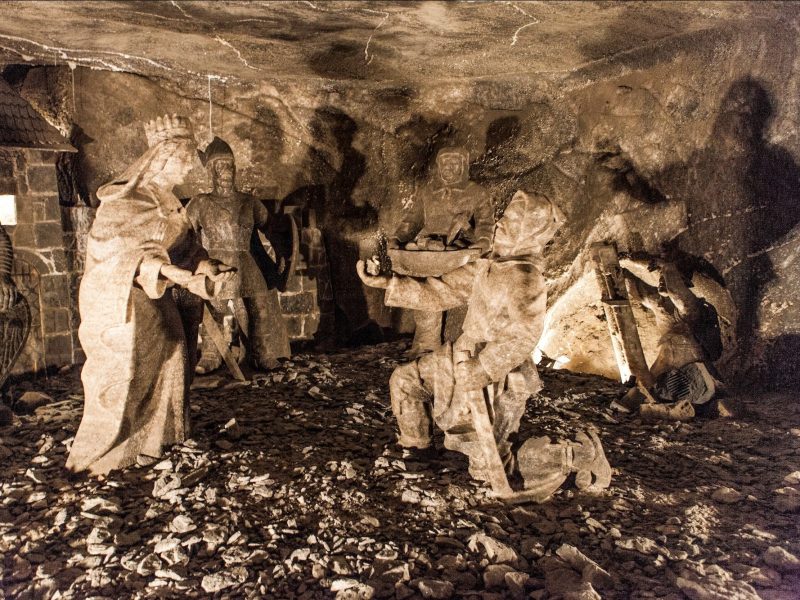
How did St Kinga make a salt mine appear in Poland? It's complicated. According to UNESCO, the legend goes like this:
Kinga, a Hungarian princess, was due to marry Duke Bolesław of Poland. They were both rich, so she didn't think it was important to bring money to the marriage. Instead, she asked her father to make her dowry up in salt.
This was difficult, as it would take an entire salt mine. Her father took her to visit a Hungarian salt mine to demonstrate the point.
Seeking God's advice, Kinga dropped her engagement ring into the mine shaft.
When she married, she moved to Poland and an amazing thing happened. She was touring her new estate and, at a certain point, ordered her men to start digging. They found huge salt deposits. To tell her of the find, one of her men presented her with a lump of white rock salt.
When she broke it open, encased inside was the wedding ring she had dropped into the Hungarian mine. She had miraculously brought a salt mine to Poland with her ring.
The salt found under there brought great wealth to her people, and Kinga was said to be a kind and just ruler. She was later canonized.
Just off the upper gallery at St Kinga's chapel, visitors can choose two routes: the miners' route, which gives a technical history of mining, and the more scenic tourists' route. The tourist route takes you down more than 800 steps.

The route takes you down through four different "storeys" nearly 450 feet deep underground.
There's just over two miles along passageways, staircases and caverns on the tour. It can be a little chilly, at around 62 degrees.
Source: Wieliczka Salt Mine.
It's very, very, very deep. Here is a view down the stairwell descending through one of the main shafts.
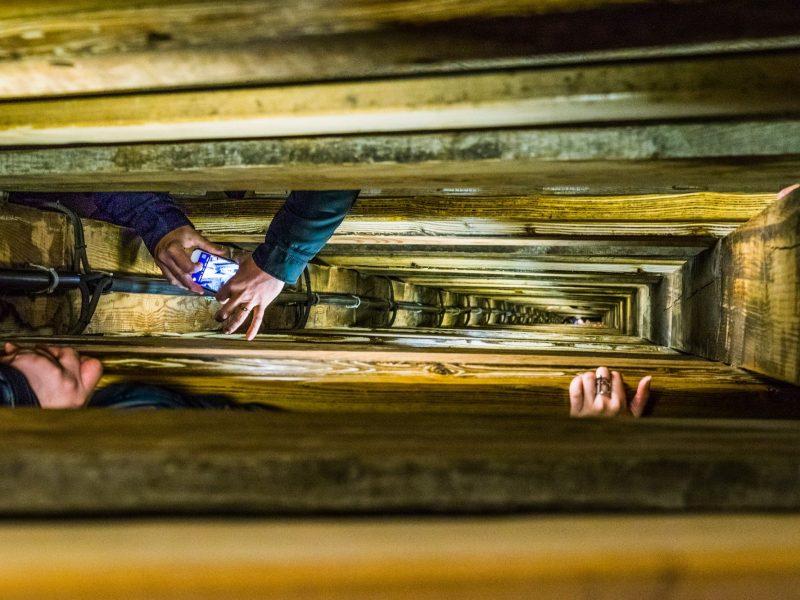
Thankfully at the bottom, you don't have to climb all those stairs back up. There's an elevator for that.
Source: Wieliczka Salt Mine.
In the 19th century, though, the miners didn't have the luxury of a staircase. This engraving from the time shows the "devil's drop", which lowered miners down to the pit face by rope.
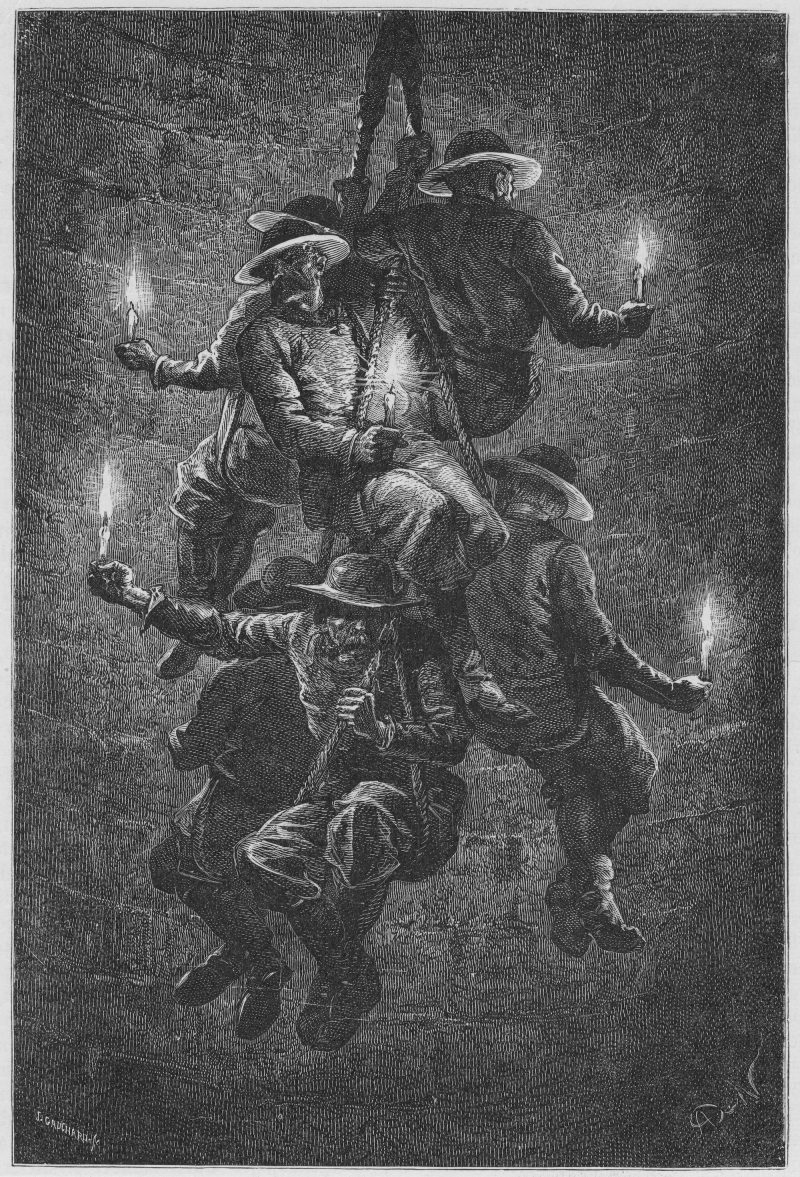
Source: Wieliczka Salt Mine.
Miners at Wieliczka prayed before starting this dangerous work. This is a view of St Anthony's chapel, carved in the 17th century, just next to the descent. Pretty much everything you see here is carved out of sugar. Just kidding. It's salt.
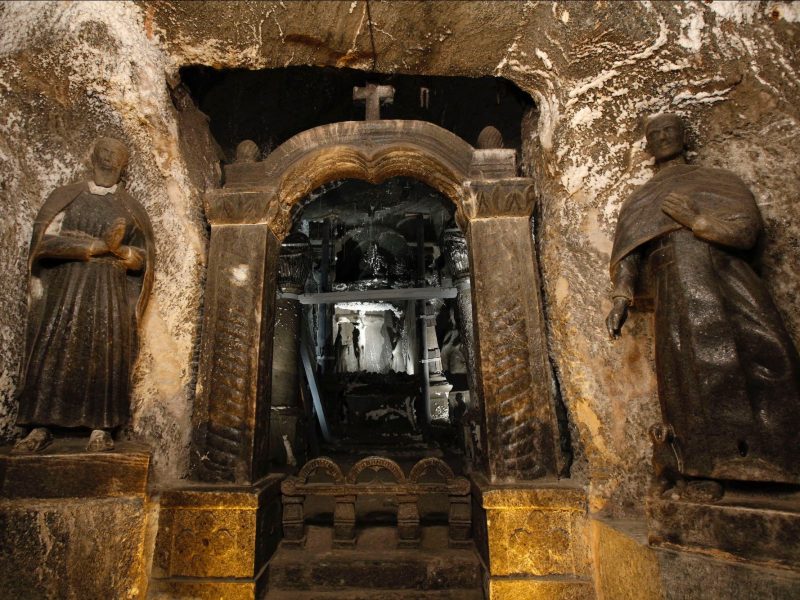
Sadly, the carvings have seen some damage due to moist air travelling up the shaft.
Source: Wieliczka Salt Mine.
Here's a view from below of some of the massive wooden support structures the miners built.
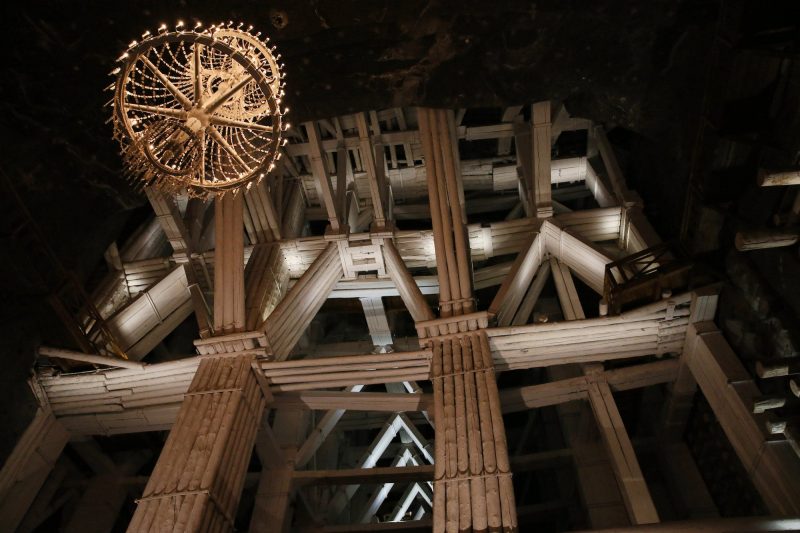
Here is a box crib passageway, the wooden structure miners would build to stop cave-ins.

Source: Wieliczka Salt Mine.
One of the most awe-inspiring sights on your journey are the underground saline lakes. This romantic spot is a popular place for marriage proposals.

Source: Wieliczka Salt Mine.
Lake Wessel is another of the lakes. The mine's proximity to underground salt water must be constantly managed and in 1993, the lowest levels of the mine — well below Lake Wessel — flooded completely.

The flood hit on April 13, 1993. The water suddenly gushed in at the lowest levels at 100 gallons a minute, according to the AP.
The floods continued for around eight months, completely filling the lowest levels 1,079 feet down, the agency reported. As the floods were below the tourist levels, there were no casualties reported at the time.
Today, the water is under control, but the disaster contributed to the decision to end commercial salt mining there.
Tourists were even visiting the lakes in the 19th century, as this engraving shows.

Source: Wieliczka Salt Mine.
The underground water makes the air damp. Over time, this causes salt crystals to form everywhere, making stalactites and coating objects. Leave something down here long enough, and this is what it will end up like.

There are dioramas throughout, demonstrating mining history and techniques. Here, a method of extracting salt from saltwater is on display.
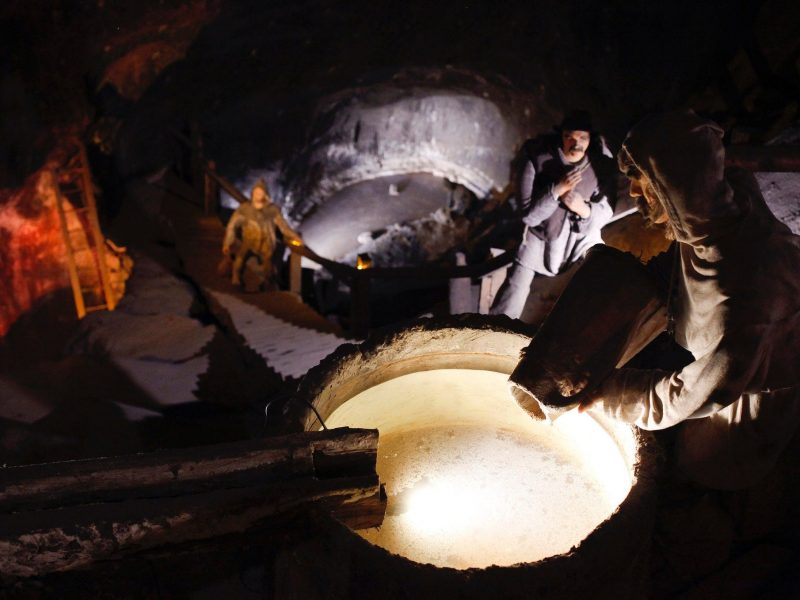
One of the caverns, the Stanisław Staszic chamber, is so large that it hosted a world record attempt for underground ballooning in 2000. Balloonist Krzysztof Rekas managed to float 7 feet off the cavern floor, 410 feet underground.
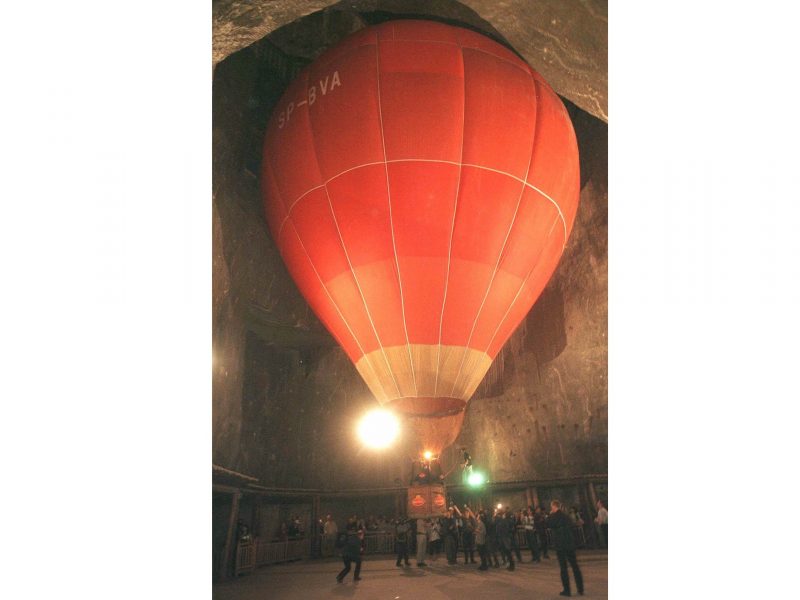
The Stanisław Staszic chamber is one of the largest caverns in the mine. One of the biggest worries for the world record attempt was crashing into the walls, according to Money.pl.
To achieve the record, he didn't have to fly very high - just enough to get off the ground, the site reported.
However, Rekas' record was later bested by Austrian balloonist Ivan Trifonov who sailed his balloon 675 ft deep into a Croatian cave in 2014, according to the Guinness Book of Records.
Source: Wieliczka Salt Mine.
Salt carving continues in Wieliczka. When the Italian national soccer team was hosted in Wieliczka during the Euro 2012 championship, contemporary sculptors were commissioned to create gifts for the players.

Here is sculptor Stanislaw Aniol shown carving a sculpture of the city's keys for the players out of salt.
Players also received soccer balls and boots carved out of salt.

The mines have had many honored guests. Here's the UK's Prince Edward and his wife Sophie, Countess of Wessex, being shown round when they visited Poland in 2004.

The mine has also hosted important political summits. Second from the left here is Donald Tusk, the then-prime minister of Poland, welcoming the leaders of the Czech Republic, Slovakia and Hungary to a meeting.
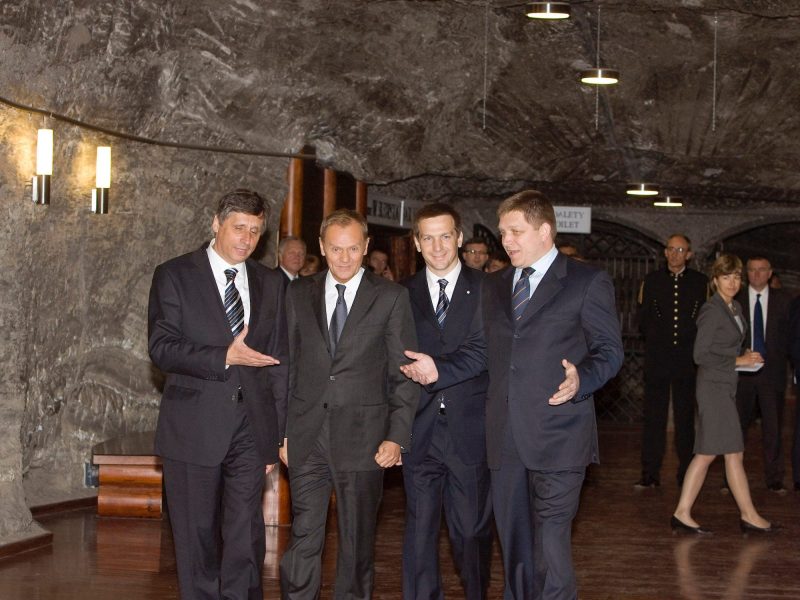
The salt mine is a point of great national pride, which Tusk demonstrated by inviting fellow members of the Visegrád Group to meet there.
The Visegrád Group, or V4, is an alliance of four Eastern European nations, headed at the time by Tusk, Jan Fischer of the Czech Republic, Gordon Bajnai of Hungary and Robert Fico of Slovakia.
Tusk later went on to become president of the European Council between 2014-2019.
Salt from Wieliczka comes in several colors, including shades of green, grey and gold. Here, the sculptor has used a honey-colored rock salt to highlight baby Jesus in a nativity scene in St Kinga's chapel.
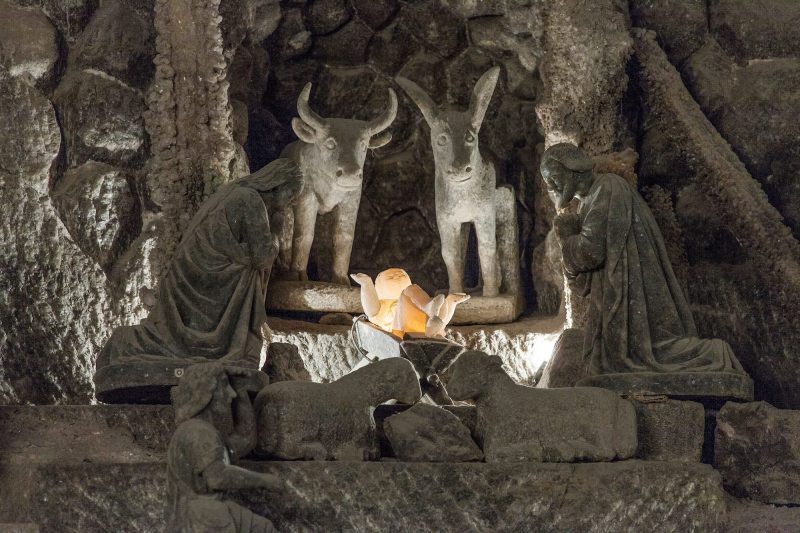
Green salt is the most common at Wieliczka. The honey-colored salt used here is called fore-shaft salt and is one of the most valuable out of numerous types found in the mine.
Source: Wieliczka Salt Mine.
